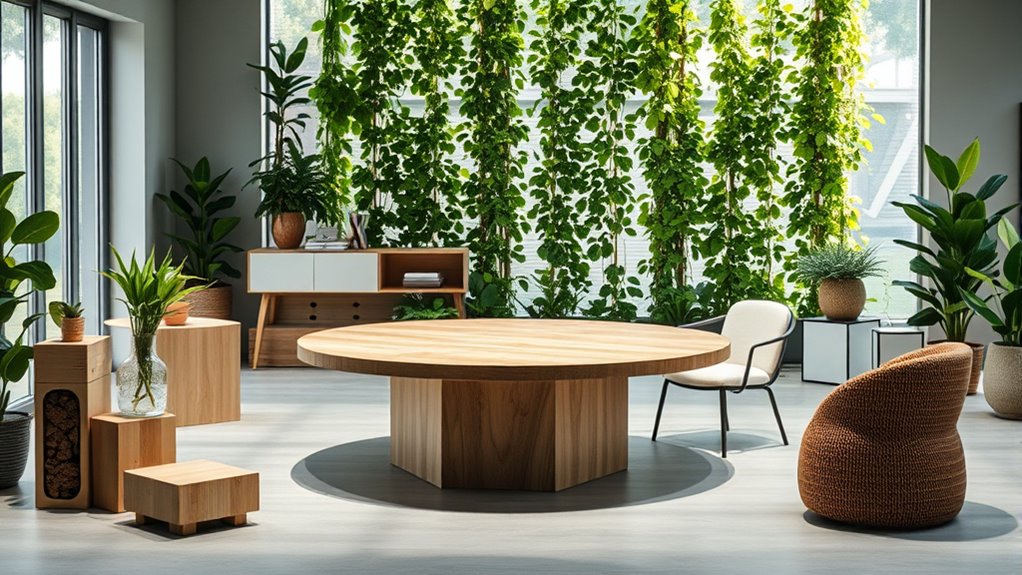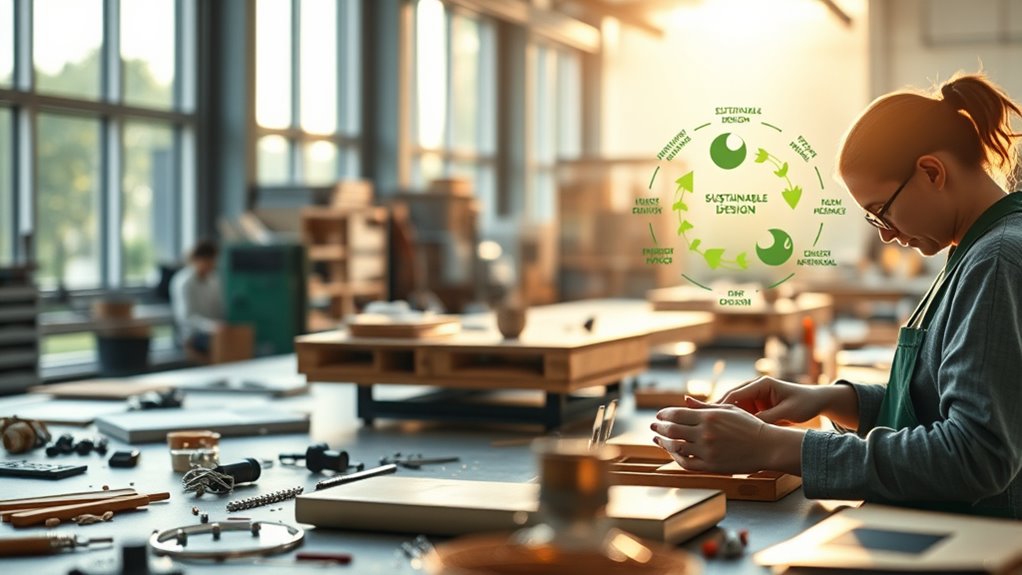Cradle-to-Cradle design invites you to create products with their entire lifecycle in mind, emphasizing sustainability and waste reduction. By choosing eco-friendly materials and designing for reuse, recycling, and disassembly, you help transform manufacturing into a closed-loop system. This approach minimizes environmental impact and promotes ongoing resource renewal. If you want to discover how this sustainable mindset can shape innovative products and future practices, explore further to uncover more insights.
Key Takeaways
- Cradle-to-Cradle emphasizes designing products for complete lifecycle reuse, minimizing waste and environmental impact.
- It advocates selecting sustainable, recyclable materials that can safely re-enter the environment or be reused.
- Incorporating modular and disassembly-friendly designs facilitates recycling and repurposing of products.
- Lifecycle considerations include planning from the outset for durability, recyclability, and resource efficiency.
- The approach promotes continuous renewal cycles, transforming manufacturing into eco-friendly, closed-loop systems.

Have you ever wondered if products could be designed to never become waste? The idea might seem ambitious, but it’s at the core of the cradle-to-cradle philosophy. Instead of following the traditional linear model—where raw materials are extracted, used, and then discarded—this approach emphasizes creating products that fit into a continuous cycle. By integrating sustainable materials and closed loop systems, you can help transform manufacturing into an eco-friendly process that minimizes environmental impact and maximizes resource efficiency.
Using sustainable materials is vital for making this vision a reality. These materials are chosen for their ability to be safely returned to the environment or reused without losing quality. Think of biodegradable plastics, recycled metals, or natural fibers that can be regenerated or repurposed. When you design products with sustainable materials, you’re not just reducing harm; you’re actively contributing to a system where waste is eliminated. This approach ensures that what you produce can either re-enter the environment safely or be reincorporated into new products, maintaining a balance that benefits both the planet and consumers.
Choosing sustainable materials ensures products can be safely reused or returned to nature, eliminating waste and supporting eco-friendly cycles.
Central to this concept is the idea of closed loop systems. Unlike traditional manufacturing, which often ends with waste, closed loop systems create a continuous cycle of reuse. When you design with these systems in mind, you develop products that are easily disassembled, recycled, or repurposed. For example, a clothing manufacturer might use modular designs that allow for easy disassembly and recycling of individual components. This way, materials aren’t discarded but are kept within the cycle, reducing the need for virgin resources and decreasing landfill waste. You’re essentially creating an ecosystem where products are perpetually renewed, not discarded.
Implementing cradle-to-cradle principles requires thoughtful planning from the beginning. You need to take into account how your product will be used, disposed of, and reintegrated into the cycle. This means selecting materials that are compatible with recycling processes and designing for longevity and reusability. It also involves establishing partnerships with recycling facilities or innovators who can help turn used products into raw materials again. By doing so, you’re not just designing a product—you’re designing a system that sustains itself. Incorporating material compatibility and considering the full lifecycle ensures that your design aligns with sustainable practices. Additionally, understanding the sustainable materials available can help you choose options that have a lower environmental impact and are compatible with recycling systems.
In addition, understanding the importance of material selection and its compatibility with recycling processes is essential for achieving true cradle-to-cradle design. By doing so, you’re not just designing a product—you’re designing a system that sustains itself.
In the end, embracing cradle-to-cradle ideas empowers you to be part of a shift toward sustainable innovation. You’re creating products that serve their purpose without leaving a harmful legacy. Instead of contributing to waste, you’re fostering a cycle of renewal—one that benefits the environment, economy, and future generations. It’s a smarter, more responsible way to think about design, where waste is no longer inevitable but entirely preventable.
Frequently Asked Questions
How Does C2C Influence Global Supply Chains?
You see, Cradle-to-Cradle influences global supply chains by promoting supply chain transparency and ethical sourcing. It encourages you to choose suppliers that prioritize recyclability and sustainable materials, reducing environmental impact. As a result, you foster responsible production practices, enhance brand reputation, and support circular economy principles. This shift pushes supply chains toward more sustainable, accountable operations, ultimately benefiting both the planet and your business’s long-term success.
Are There Certifications for Cradle-To-Cradle Products?
You’ll find that cradle-to-cradle products often have certifications backed by third-party verification, ensuring they meet specific standards. These certification standards assess a product’s environmental impact, material health, and recyclability, giving you confidence in its sustainability. When choosing cradle-to-cradle products, look for recognized certifications like the Cradle to Cradle Certified™ mark, which guarantees the product aligns with rigorous sustainability criteria verified independently by trusted organizations.
What Industries Are Leading in C2C Implementation?
Imagine industries racing to be eco-heroes, yet some still cling to outdated norms. You’ll find that the fashion and construction sectors lead the charge in C2C implementation, embracing sustainable material sourcing and circular design strategies. These industries are transforming waste into resource, proving that eco-conscious innovation isn’t just a trend but a necessity. It’s a visual reminder that forward-thinking can turn old rules into new, sustainable standards.
How Can Small Businesses Adopt C2C Principles Affordably?
You can adopt C2C principles affordably by prioritizing eco-friendly materials and designing products for reuse or recycling. Embrace circular business models that reduce waste and extend product lifecycles, which can lower costs and attract eco-conscious customers. Start small by offering repair services or take-back programs, and gradually expand your efforts. These strategies help you implement sustainable practices without significant upfront investments, making C2C principles accessible for small businesses.
What Are Common Challenges in Designing C2C Products?
Imagine you’re steering a river maze, trying to avoid hidden rocks. Designing C2C products faces similar challenges. Supply chain complexities can throw you off course, making it hard to track materials or guarantee recyclability. Material selection becomes a puzzle—choosing eco-friendly options that perform well without harming the environment. These hurdles require careful planning and adaptability, but overcoming them leads to sustainable, fully circular products that benefit everyone.
Conclusion
By designing products with their entire life cycle in mind, you can create sustainable solutions that benefit both the environment and future generations. Imagine using biodegradable packaging that decomposes naturally, reducing waste and pollution. For example, a clothing brand could implement cradle-to-cradle principles by recycling old garments into new textiles, closing the loop. Embracing this approach not only minimizes your ecological footprint but also sets a new standard for responsible innovation and conscious consumption.










